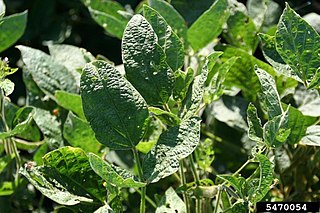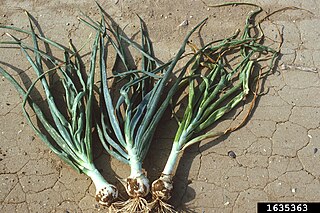
Narcissus is a genus of predominantly spring flowering perennial plants of the amaryllis family, Amaryllidaceae. Various common names including daffodil, narcissus, and jonquil are used to describe all or some members of the genus. Narcissus has conspicuous flowers with six petal-like tepals surmounted by a cup- or trumpet-shaped corona. The flowers are generally white and yellow, with either uniform or contrasting coloured tepals and corona.

Potyviridae is a family of positive-strand RNA viruses that encompasses more than 30% of known plant viruses, many of which are of great agricultural significance. The family has 12 genera and 235 species, three of which are unassigned to a genus.

Plum pox, also known as sharka, is the most devastating viral disease of stone fruit from the genus Prunus. The disease is caused by the plum pox virus (PPV), and the different strains may infect a variety of stone fruit species including peaches, apricots, plums, nectarine, almonds, and sweet and tart cherries. Wild and ornamental species of Prunus may also become infected by some strains of the virus.

Potyvirus is a genus of positive-strand RNA viruses in the family Potyviridae. Plants serve as natural hosts. The genus is named after member virus potato virus Y. Potyviruses account for about thirty percent of the currently known plant viruses. Like begomoviruses, members of this genus may cause significant losses in agricultural, pastoral, horticultural, and ornamental crops. More than 200 species of aphids spread potyviruses, and most are from the subfamily Aphidinae. The genus contains 190 species.
Bean yellow mosaic virus is a plant pathogenic virus in the genus Potyvirus and the virus family Potyviridae. Like other members of the Potyvirus genus, it is a monopartite strand of positive-sense, single-stranded RNA surrounded by a capsid made for a single viral encoded protein. The virus is a filamentous particle that measures about 750 nm in length. This virus is transmitted by species of aphids and by mechanical inoculation.
Potato virus Y (PVY) is a plant pathogenic virus of the family Potyviridae, and one of the most important plant viruses affecting potato production.

Soybean mosaic virus (SMV) is a member of the plant virus genus Potyvirus. It infects mainly plants belonging to the family Fabaceae but has also been found infecting other economically important crops. SMV is the cause of soybean mosaic disease that occurs in all the soybean productions areas of the world. Soybean is one of the most important sources of edible oil and proteins and pathogenic infections are responsible for annual yield losses of about $4 billion in the United States. Among these pathogens, SMV is the most important and prevalent viral pathogen in soybean production worldwide. It causes yield reductions of about 8% to 35% but losses as high as 94% have been reported.

Carlavirus, formerly known as the "Carnation latent virus group", is a genus of viruses in the order Tymovirales, in the family Betaflexiviridae. Plants serve as natural hosts. There are 53 species in this genus. Diseases associated with this genus include: mosaic and ringspot symptoms.

Tulip breaking virus is one of five plant viruses of the family Potyviridae that cause color-breaking of tulip flowers. These viruses infect plants in only two genera of the family Liliaceae: tulips (Tulipa) and lilies (Lilium).
Commelina mosaic virus (CoMV) is a plant pathogenic virus in the genus Potyvirus and the virus family Potyviridae. Like other members of the Potyvirus genus, CoMV is a monopartite strand of positive-sense, single-stranded RNA surrounded by a capsid made for a single viral encoded protein. The virus is a filamentous particle that measures about 707-808 nm in length. This virus is transmitted by two species of aphids, Myzus persicae and Aphis gossypii, and by mechanical inoculation.
Clover yellow vein virus (ClYVV) is a plant pathogenic virus in the genus Potyvirus and the virus family Potyviridae. Like other members of the Potyvirus genus, ClYVV is a monopartite strand of positive-sense, single-stranded RNA surrounded by a capsid made for a single viral encoded protein. The virus is a filamentous particle that measures about 760 nm in length. This virus is transmitted by several species of aphids in a nonpersistent manner and by mechanical inoculation.

Watermelon mosaic virus (WMV) also known as Marrow mosaic virus, Melon mosaic virus, and until recently Watermelon mosaic virus type 2 (WMV-2), is a plant pathogenic virus that causes viral infection in many different plants. The virus itself is referred to as Watermelon Mosaic Virus II or WMV-2 and is an isolate of the U.S. WMV-2 is a ssRNA positive strand virus that is part of the Potyviridae or Potyvirus clade. Like all RNA viruses, it contains a protein capsid which protects the inner viral RNA. First described on squash in Florida, WMV arose from a unique recombination of genetic material contributed by Soybean mosaic virus (SMV) and Bean common mosaic virus (BCMV) along with Peanut Stripe virus (PSV).
Narcissus common latent virus (NCLV) is a plant pathogenic virus. It infects Narcissus plants. The term 'latent' refers to the fact that infection may be symptomless. Transmission occurs by Aphids.
Narcissus latent virus (NLV) is a Macluravirus, a plant pathogenic virus of the family Potyviridae, which infects Narcissus.
Nerine latent virus (NeLV) is a plant pathogenic virus. It infects Nerine, Narcissus, Hippeastrum and Ismene plants.
Narcissus yellow stripe potyvirus (NYSV) is a plant pathogenic Potyvirus of the family Potyviridae which infects plants of the genus Narcissus. It is one of the commoner viruses infecting Narcissus, and is transmitted by aphids.
Narcissus tip necrosis virus (NTNV) is a plant pathogenic virus of the family Tombusviridae, which infects plants of the genus Narcissus, the only known host.
''Narcissus white streak virus (NWSV) is a plant pathogen of the family Potyviridae which infects plants of the genus Narcissus, and is transmitted by aphids. It is among the commonest and most serious of the viral infections that infect narcissi, but appears to be confined to N. tazetta.
Carrot virus Y (CarVY) is a (+)ss-RNA virus that affects crops of the carrot family (Apiaceae), such as carrots, anise, chervil, coriander, cumin, dill and parsnip. Carrots are the only known crop to be infected in the field. Infection by the virus leads to deformed roots and discolored or mottled leaves. The virus is spread through insect vectors, and is currently only found in Australia.

Onion yellow dwarf virus (OYDV) is a plant virus in the genus Potyvirus that has been identified worldwide and mainly infects species of Allium such as onion, garlic, and leek. The virus causes mild to severe leaf malformation, and bulb reduction up to sixty percent has been observed in garlic.






